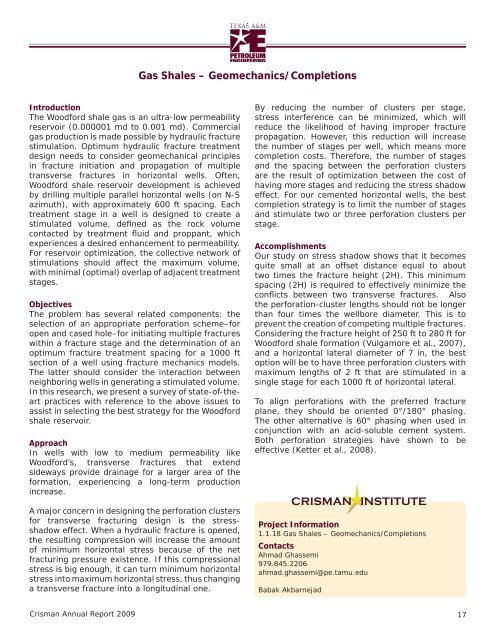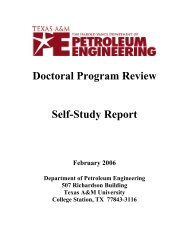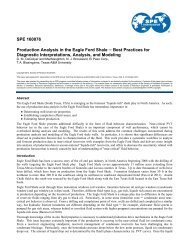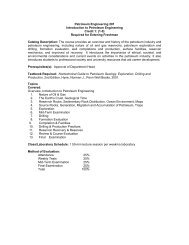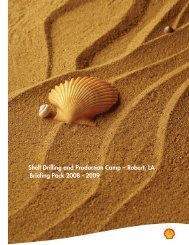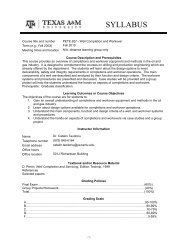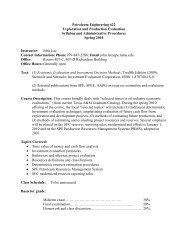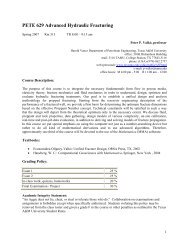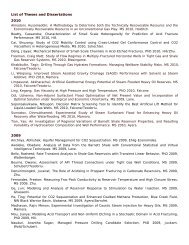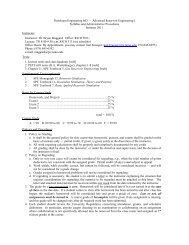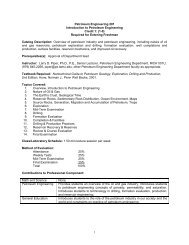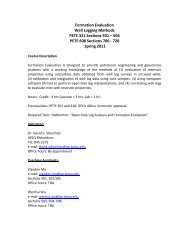Crisman Annual Report 2009 - Harold Vance Department of ...
Crisman Annual Report 2009 - Harold Vance Department of ...
Crisman Annual Report 2009 - Harold Vance Department of ...
Create successful ePaper yourself
Turn your PDF publications into a flip-book with our unique Google optimized e-Paper software.
Gas Shales – Geomechanics/Completions<br />
Introduction<br />
The Woodford shale gas is an ultra-low permeability<br />
reservoir (0.000001 md to 0.001 md). Commercial<br />
gas production is made possible by hydraulic fracture<br />
stimulation. Optimum hydraulic fracture treatment<br />
design needs to consider geomechanical principles<br />
in fracture initiation and propagation <strong>of</strong> multiple<br />
transverse fractures in horizontal wells. Often,<br />
Woodford shale reservoir development is achieved<br />
by drilling multiple parallel horizontal wells (on N-S<br />
azimuth), with approximately 600 ft spacing. Each<br />
treatment stage in a well is designed to create a<br />
stimulated volume, defined as the rock volume<br />
contacted by treatment fluid and proppant, which<br />
experiences a desired enhancement to permeability.<br />
For reservoir optimization, the collective network <strong>of</strong><br />
stimulations should affect the maximum volume,<br />
with minimal (optimal) overlap <strong>of</strong> adjacent treatment<br />
stages.<br />
Objectives<br />
The problem has several related components: the<br />
selection <strong>of</strong> an appropriate perforation scheme–for<br />
open and cased hole–for initiating multiple fractures<br />
within a fracture stage and the determination <strong>of</strong> an<br />
optimum fracture treatment spacing for a 1000 ft<br />
section <strong>of</strong> a well using fracture mechanics models.<br />
The latter should consider the interaction between<br />
neighboring wells in generating a stimulated volume.<br />
In this research, we present a survey <strong>of</strong> state-<strong>of</strong>-theart<br />
practices with reference to the above issues to<br />
assist in selecting the best strategy for the Woodford<br />
shale reservoir.<br />
Approach<br />
In wells with low to medium permeability like<br />
Woodford’s, transverse fractures that extend<br />
sideways provide drainage for a larger area <strong>of</strong> the<br />
formation, experiencing a long-term production<br />
increase.<br />
A major concern in designing the perforation clusters<br />
for transverse fracturing design is the stressshadow<br />
effect. When a hydraulic fracture is opened,<br />
the resulting compression will increase the amount<br />
<strong>of</strong> minimum horizontal stress because <strong>of</strong> the net<br />
fracturing pressure existence. If this compressional<br />
stress is big enough, it can turn minimum horizontal<br />
stress into maximum horizontal stress, thus changing<br />
a transverse fracture into a longitudinal one.<br />
By reducing the number <strong>of</strong> clusters per stage,<br />
stress interference can be minimized, which will<br />
reduce the likelihood <strong>of</strong> having improper fracture<br />
propagation. However, this reduction will increase<br />
the number <strong>of</strong> stages per well, which means more<br />
completion costs. Therefore, the number <strong>of</strong> stages<br />
and the spacing between the perforation clusters<br />
are the result <strong>of</strong> optimization between the cost <strong>of</strong><br />
having more stages and reducing the stress shadow<br />
effect. For our cemented horizontal wells, the best<br />
completion strategy is to limit the number <strong>of</strong> stages<br />
and stimulate two or three perforation clusters per<br />
stage.<br />
Accomplishments<br />
Our study on stress shadow shows that it becomes<br />
quite small at an <strong>of</strong>fset distance equal to about<br />
two times the fracture height (2H). This minimum<br />
spacing (2H) is required to effectively minimize the<br />
conflicts between two transverse fractures. Also<br />
the perforation-cluster lengths should not be longer<br />
than four times the wellbore diameter. This is to<br />
prevent the creation <strong>of</strong> competing multiple fractures.<br />
Considering the fracture height <strong>of</strong> 250 ft to 280 ft for<br />
Woodford shale formation (Vulgamore et al., 2007),<br />
and a horizontal lateral diameter <strong>of</strong> 7 in, the best<br />
option will be to have three perforation clusters with<br />
maximum lengths <strong>of</strong> 2 ft that are stimulated in a<br />
single stage for each 1000 ft <strong>of</strong> horizontal lateral.<br />
To align perforations with the preferred fracture<br />
plane, they should be oriented 0°/180° phasing.<br />
The other alternative is 60° phasing when used in<br />
conjunction with an acid-soluble cement system.<br />
Both perforation strategies have shown to be<br />
effective (Ketter et al., 2008).<br />
CRISMAN INSTITUTE<br />
Project Information<br />
1.1.18 Gas Shales – Geomechanics/Completions<br />
Contacts<br />
Ahmad Ghassemi<br />
979.845.2206<br />
ahmad.ghassemi@pe.tamu.edu<br />
Babak Akbarnejad<br />
<strong>Crisman</strong> <strong>Annual</strong> <strong>Report</strong> <strong>2009</strong><br />
17


